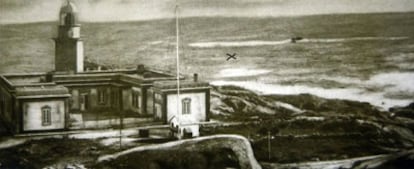Unfounded (but not wreckless) claims 90 years after Galician sea disaster
Bay of Arousa commemorates anniversary of a famous shipwreck
The Costa da Morte (Death Coast), where the iron-bound promontory of Finisterre sticks far out into the Atlantic, is notorious for shipwrecks. But one of Galicia's best remembered wrecks took place further south, in the Ría de Arousa estuary. In 1921 the Santa Isabel, a mail packet, sank about 100 meters from the now-deserted island of Sálvora, which in those days was still inhabited, and the courage of the people there has become a legend.
This year sees the 90th anniversary of the wreck, and Xosé María Fernández Pazos is bringing out a new edition of his 1998 book on the tragedy, Sálvora: Memoria dun Naufraxio (or, Sálvora: Memory of a shipwreck), updated with new photographs.
The radio SOS message was cut off thus: "We are on the rocks at Sál..."
There is a dark legend that accuses the locals of stealing victims' belongings
At 1.50am on January 2, 1921 the ship ran aground on some rocks near Sálvora, and quickly capsized. The island people, especially three young women, managed to save 56 passengers. They were celebrated as heroines, received various medals, and royal recognition of their village, Ribeira, in the form of the title "Noble, loyal and hospitable."
The ship had visited several ports along Spain's north coast, collecting emigrants bound for America; its destination being Cádiz in the south, whence the bigger transatlantic ships set out. Attempting to enter the Arousa estuary, the Santa Isabel ran onto rocks. Several rents were torn in the hull, and it went quickly under. The ship's electric power failed and the radio SOS message was cut off thus: "We are on the rocks at Sál..." The listeners at Finisterre Radio did not know where to send a rescue team.
It was the island's lighthouse keeper who first heard the passengers' shouts. He ran to a cluster of houses, two kilometers from the lighthouse, to get help. Three boats set out: one to the village of Ribeira to report the wreck, and two directly to the place where the packet had sunk. Though sea rescue is commonly thought of as a man's job, one of the latter boats was crewed by three young women: Cipriana Oujo, 25; Josefa Parada, 16; and María Fernández, who was just 14. Braving heavy seas and making several trips, they rescued between 15 and 20 of the total of 56 people saved. Even so, the death toll was 213. The town council of Ribeira had to reopen a disused cemetery for the bodies.
The second mate of the Santa Isabel, Luis Cebreiro of El Ferrol in Galicia, also saved many lives that night. He kept several lifeboats from approaching the shore until dawn, knowing it would then be easier to dodge the rocks. He also refused to climb aboard a boat, being a very corpulent man - his nickname was Toneladas (tons) - and fearing he would sink it. He got a medal: not his first one, for he had been in several shipwrecks. "Perhaps he was jinxed; perhaps it was just by chance," says Fernández. From the Spanish Council of State, the three women received the Maritime Rescue Cross, Third Class, sweetened with a state grant of 3,000 pesetas each (a respectable sum in 1921).
However, there is also a dark legend that accuses the people of Sálvora of appropriating the victims' belongings. Little more was ever heard of the three heroines; it is said they were loath to speak of what happened that night. Fernández Pazos explains that in the village hall there are few documents about the wreck. "The people opted for silence, in view of the rumors that accused them of being raqueiros [wreckers or looters]," Fernández Pazos says. After viewing a file of documents kept by the second mate, Luis Cebreiro, the historian feels the rumors are unfounded.

Tu suscripción se está usando en otro dispositivo
¿Quieres añadir otro usuario a tu suscripción?
Si continúas leyendo en este dispositivo, no se podrá leer en el otro.
FlechaTu suscripción se está usando en otro dispositivo y solo puedes acceder a EL PAÍS desde un dispositivo a la vez.
Si quieres compartir tu cuenta, cambia tu suscripción a la modalidad Premium, así podrás añadir otro usuario. Cada uno accederá con su propia cuenta de email, lo que os permitirá personalizar vuestra experiencia en EL PAÍS.
¿Tienes una suscripción de empresa? Accede aquí para contratar más cuentas.
En el caso de no saber quién está usando tu cuenta, te recomendamos cambiar tu contraseña aquí.
Si decides continuar compartiendo tu cuenta, este mensaje se mostrará en tu dispositivo y en el de la otra persona que está usando tu cuenta de forma indefinida, afectando a tu experiencia de lectura. Puedes consultar aquí los términos y condiciones de la suscripción digital.








































